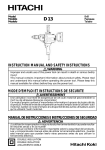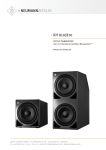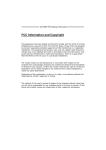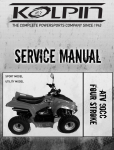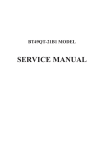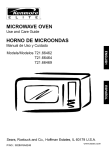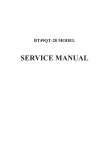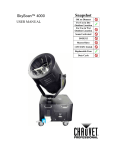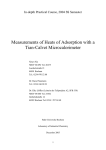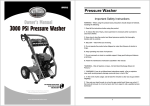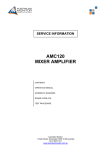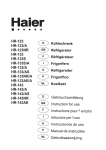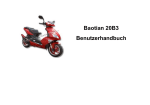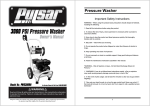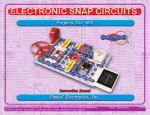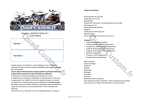Download Manual del usuario Owner`s handbook
Transcript
STREPPER Manual del usuario STREPPER Owner’s handbook Toda la información, ilustraciones, fotografías y especificaciones contenidas en este manual están basadas en la última información disponible sobre el producto en el momento de la publicación. Debido a las mejoras y a otros cambios, es posible que haya algunas discrepancias en este manual. CLIPIC se reserva el derecho de realizar cambios en cualquier momento sin previo aviso. All information, illustration, photographs and specifications contained in this manual are based on the latest product information available at time of publication. Due to inprovements or other changes, there may be some discrepancies in this manual. CLIPIC reserve the right to make changes at any time without notice. 1a edición 2005 Diseño y confección: www.ciandisseny.com Editado por: Clipic, S, C. STREPPER Manual del usuario STREPPER O ’ h db k Índice ÍNDICE PRECAUCIONES IMPORTANTES 6 INFORMACIÓN PARA EL CONSUMIDOR 7 UBICACIÓN DE LOS COMPONENTES 13 CONTROLES Llave Interruptor encendido Tablero de instrumentos Puño izquierdo Puño derecho Tapón del depósito de combustible Llave de combustible Pedal de arranque Pedal de freno trasero Palanca de cambio Bloqueo de dirección Soporte para el casco 16 16 17 18 19 21 22 23 23 24 25 25 RECOMENDACIONES PARA LA GASOLINA Y EL ACEITE DE MOTOR 26 RODAJE 27 COMPROBACIONES ANTES DE CONDUCIR 4 29 Índice CONSEJOS PARA LA CONDUCCIÓN Poner en marcha el motor Empezar a circular Conducir por una pendiente Parar y aparcar 31 32 34 35 35 COMPROBACIONES Y MANTENIMIENTO Tabla de mantenimiento periódico Lubricación Batería Filtro aire Bujía Aceite de transmisión Carburador Ajuste del cable del gas Cadena de transmisión Frenos Neumáticos Cambio de la bombilla 37 38 41 41 42 44 45 46 48 48 52 56 58 DIAGNÓSTICO DE PROBLEMAS 59 SPECIFICACIONES ST50 61 SPECIFICACIONES ST9 64 ST50 / ST90 SISTEMA ELÉCTRICO 67 5 Precauciones importantes PRECAUCIONES IMPORTANTES INFORMACIÓN DE RODAJE PARA SU MOTOCICLETA Los primeros 1.600 Km. son los más importantes de la vida de la motocicleta. El rodaje adecuado durante este período ayudará a garantizar un vida útil muy larga y el mejor rendimiento de su nueva motocicleta. La fiabilidad y el rendimiento de la motocicleta dependen de los cuidados especiales y del hecho de circular con ella con precaución durante el período de rodaje. No haga funcionar el motor de una manera en que sus piezas queden expuestas a un calor excesivo. Consulte la sección “rodaje”, donde encontrará recomendaciones específicas para el rodaje. Lea todo este manual y las siguientes instrucciones con atención. Para enfatizar la información especial, se utilizan las palabras ADVERTENCIA, PRECAUCIÓN y NOTA para resaltar algunos puntos, que deberán leerse con mucha atención. ADVERTENCIA Si se ignora esta información el conductor puede resultar lesionado. Puede verse afectada la seguridad personal del conductor. PRECAUCIÓN Estas instrucciones señalan procedimientos de revisión especiales o precauciones que deberán tenerse en cuenta para evitar dañar la máquina. NOTA Ofrecen información especial para facilitar el mantenimiento o aclarar las instrucciones más importantes. 6 Información para el consumidor INFORMACIÓN PARA EL CONSUMIDOR INSTALACIÓN DE ACCESORIOS Y CONSEJOS DE SEGURIDAD Existe una gran variedad de accesorios disponibles para los propietarios de CLIPIC. La instalación de unos accesorios inadecuados puede llevar a unas condiciones de uso inseguras. Para la instalación adecuada de los accesorios hemos incluido algunos consejos que le ayudarán a seleccionar e instalar correctamente los accesorios. 1. Si desea instalar un accesorio que resultará en un peso adicional o en un efecto aerodinámico para su motocicleta, intente instalarlo lo más bajo posible y lo más próximo posible al centro de gravedad de la motocicleta. Compruebe atentamente el soporte para la instalación de accesorios para estar seguro de su firmeza. Si la instalación no es segura, la conducción será inestable y peligrosa debido al desplazamiento del peso. 2. Compruebe la distancia mínima al suelo y el ángulo de giro para comprobar que sean los adecuados. La carga inadecuada, que puede resultar después de la instalación de accesorios, hará que la seguridad se vea negativamente afectada. También deberá comprobarse que la carga inadecuada no afecte al RALENTÍ, el giro y otras acciones de control. 7 Información para el consumidor 3. La instalación de accesorios en el manillar o en la horquilla delantera resultarán en una conducción inestable. Este peso adicional reducirá la maniobrabilidad de la motocicleta durante las operaciones de giro. Este peso adicional también provocará inestabilidad debido a las vibraciones que se producirán en la parte delantera. Así pues, no instale nunca accesorios en el manillar o en la horquilla frontal. 4. Los accesorios como un carenado, un parabrisas, un apoyo para la cintura, las bolsas en el asiento y las maletas tendrán un efecto aerodinámico sobre la estabilidad de la motocicleta en caso de viento lateral o cuando le adelanten vehículos de gran tamaño. La instalación inadecuada o el diseño inapropiado de los accesorios afectará a la seguridad de la conducción. Así pues, deberá tener mucho cuidado a la hora de seleccionar e instalar los accesorios. 5. Algunos accesorios desplazan al conductor de su posición de conducción normal. Esto no sólo limitará la libertad de movimientos del conductor, sino también su habilidad de control. 6. Los accesorios eléctricos adicionales pueden sobrecargar el sistema eléctrico existente. Las sobrecargas excesivas pueden dañar los haces de cables o crear una situación de peligro debido a la pérdida de potencia eléctrica durante el uso de la motocicleta. Al colocar una carga en la motocicleta, póngala lo más baja posible. Una carga colocada de una manera incorrecta hará que el centro de gravedad sea más alto, lo cual es muy peligroso y hace que la motocicleta sea más difícil de controlar. El tamaño de una carga puede afectar a la aerodinámica y al control de la motocicleta. Equilibre la carga entre el lado izquierdo y derecho de la motocicleta, y fíjela firmemente. 8 Información para el consumidor RECOMENDACIONES A LOS CONDUCTORES PARA UNA CONDUCCIÓN SEGURA Conducir una motocicleta es un deporte muy divertido y emocionante. La conducción de una motocicleta también requiere que se tomen algunas precauciones adicionales para garantizar la seguridad del conductor. Estas precauciones son: LLEVE UN CASCO El equipo de seguridad para la motocicleta empieza por un casco de alta calidad. Una de las lesiones más graves que puede sufrir un motocicletas es una lesión en la cabeza. Lleve siempre un casco homologado. También deberá llevar una protección adecuada para los ojos. PRENDAS PARA CONDUCIR Las prendas ajustadas y elegantes pueden resultar incómodas e inseguras a la hora de conducir una motocicleta. Cuando circule con la motocicleta, lleve unas prendas adecuadas de alta calidad. COMPROBACIONES ANTES DE CONDUCIR Realice todas las revisiones que se explican en la sección “INSPECCIONES PREVIAS A LA CONDUCCIÓN” de este manual. No olvide realizar todas las comprobaciones de seguridad para garantizar la seguridad del conductor. 9 Información para el consumidor FAMILIARÍCESE CON LA MOTOCICLETA Sus habilidades como conductor y sus conocimientos mecánicos determinarán la seguridad de su conducción. Le aconsejamos que practique con la motocicleta en un área sin tráfico y sin obstáculos hasta que se haya familiarizado completamente con la máquina y sus controles. Recuerde que la práctica es el único camino hacia la perfección. CONOZCA SUS LÍMITES DE VELOCIDAD SEGUROS Conduzca siempre dentro de los límites de sus propias habilidades. Conocer estos límites y conducir teniéndolos en cuenta le ayudará a no tener accidentes. TENGA MUY EN CUENTA LA SEGURIDAD EN CASO DE MAL TIEMPO La conducción en días de mal tiempo, especialmente en caso de lluvia, exige una precaución adicional. En un día de lluvia la distancia de frenado es el doble. Evite las superficies pintadas de la señalización horizontal, las tapaderas de las cloacas y las zonas que parezcan grasientas, ya que pueden ser especialmente resbaladizas. Tenga mucha precaución al cruzar vías de tren, rejillas metálicas y puentes. Siempre que tenga alguna duda sobre el estado del firme, ¡REDUZCA LA VELOCIDAD! 10 Información para el consumidor PREVENCIÓN DE ACCIDENTES DE COCHE/MOTOCICLETA Muchos accidentes de coche/motocicleta se producen debido a que el conductor del automóvil no “VE” al motociclista. Debe hacerse visible para evitar accidentes que no serán culpa suya: Lleve prendas brillantes o reflectantes No circule dentro del “punto ciego” de otro conductor. Indique siempre todos los cambios de carril o giro. Su tamaño y maniobrabilidad pueden sorprender a los demás conductores. MODIFICACIÓN La modificación de la motocicleta, o la desinstalación del equipo original, pueden hacer que el vehículo pase a ser inseguro o ilegal. Tenga siempre en cuenta las normativas locales sobre los equipos disponibles. 11 Información para el consumidor 1 UBICACIÓN DE LOS NÚMEROS DE SERIE Los números de serie del bastidor y del motor son necesarios para registrar la motocicleta. También serán necesarios para que su distribuidor pueda pedir piezas de recambio o para recibir información especial para reparaciones. El número de bastidor 1 está impreso en la superficie derecha de la cabeza de horquilla. El número del motor está impreso en el lado izquierdo del cigüeñal, y la placa de características de la motocicleta se encuentra en la parte central derecha del bastidor. Registre aquí los números para su referencia. Nº DE BASTIDOR: _____________________________ Nº DE MOTOR:________________________________ 12 3 2 Ubicación de los componentes UBICACIÓN DE LOS COMPONENTES 1 1. Botón del regulador de voltaje 2. Tablero de instrumentos 3. Interruptor del faro para conducción nocturna 4. Palanca del freno delantero 5. Puño del gas 6. Interruptor de parada del motor 7. Interruptor de los intermitentes 8. Botón de la bocina 2 3 4 8 7 6 13 5 Ubicación de los componentes 1 1. Batería 2. Depósito de combustible 3. Pedal del freno trasero 4. Estribo del conductor 5. Filtro/varilla del aceite de motor 6. Pedal de arranque 2 6 4 14 5 3 Ubicación de los componentes 1. Bloqueo de la dirección 2. Interruptor de encendido 3. Soporte para el casco 4. Amortiguador trasero 5. Palanca del cambio 6. Filtro de aire 1 2 3 4 6 15 5 Controles CONTROLES LLAVE Esta motocicleta se entrega con dos llaves de encendido idénticas. Guarde la llave de recambio en un lugar seguro. INTERRUPTOR DE ENCENDIDO Este interruptor tiene dos posiciones: 1 1 Posición “OFF” Todos los circuitos eléctricos están desconectados. Posición “ON” Todos los circuitos eléctricos están conectados y puede ponerse en marcha el motor. 16 1. Interruptor de encendido Controles TABLERO DE INSTRUMENTOS Velocímetro (1) El velocímetro indica la velocidad en kilómetros por hora. Odómetro (2) El odómetro registra la distancia total recorrida por la motocicleta. Piloto indicador de punto muerto (3) El piloto indicador verde de punto muerto se ilumina cuando el cambio está en punto muerto. Al poner alguna marcha este piloto se apaga. Piloto indicador de luces largas (4) Este piloto indicador se ilumina al poner las luces largas en el faro delantero. Piloto indicador del intermitente izquierdo./derecho (5) Este piloto indicador se ilumina cuando se activa el intermitente derecho o izquierdo. 17 1 2 4 3 5 Controles PUÑO IZQUIERDO Botón del regulador de voltaje (1) Gire el puño izquierdo hasta la posición “ ”, y las luces delantera y trasera se iluminarán en señal de advertencia. Si coloca el botón regulador de voltaje en la posición “ ”, el piloto indicador de las luces largas del faro delantero se iluminará. Si coloca el botón del regulador de voltaje en la posición “•”, se iluminarán los pilotos indicadores de las luces de posición delantero y trasero. Interruptor de los intermitentes (2) Coloque este interruptor en la posición “ ” para que empiece a funcionar el intermitente izquierdo, y en la posición “ ” para activar el intermitente derecho. En la posición central no funcionará ninguno de los intermitentes. ADVERTENCIA Utilice siempre los intermitentes cuando vaya a cambiar de carril o girar. Vuelva a colocar siempre este botón en la posición central después de terminar el giro o cambio de carril. 18 1 3 2 4 ST50 5 ST90 Controles Botón de la bocina (3) Pulse este botón para hacer sonar la bocina. 1 2 Palanca del estárter (4)”” (ST50) Al poner en marcha un motor frío, utilice la palanca del estárter. Palanca del embrague (5) (ST90) Al poner en marcha el motor o cambiar de marcha, accione la palanca del embrague para desconectar la transmisión. PUÑO DERECHO Interruptor del faro para conducción nocturna (1) Cuando el motor esté en funcionamiento, el faro delantero, la iluminación del panel y la luz trasera se iluminarán simultáneamente. Cuando el motor esté parado, podrán iluminarse el faro delantero y la luz trasera en señal de advertencia. El faro delantero, las luces de posición, la iluminación del panel y la luz trasera no se iluminarán. 19 3 4 ST50 1 3 2 4 Controles Interruptor de parada de emergencia del motor (2) En caso de emergencia, pulse este interruptor para desconectar el encendido y parar el motor. Palanca del freno delantero (3) Accione la palanca del freno delantero para aplicar este freno. ADVERTENCIA Utilizar sólo el freno delantero o el trasero es peligroso si circula a gran velocidad. Aplique siempre ambos frenos suavemente y con cuidado. Puño del gas (4) El puño del gas se utiliza para controlar la velocidad del motor. Gire el puño del gas hacia Vd. para aumentar la velocidad del motor. Suéltelo para reducir la velocidad del motor. 4 20 Controles TAPÓN DEL DEPÓSITO DE COMBUSTIBLE Para abrir el tapón del depósito de combustible, gírelo en la dirección “A” hasta la posición “ON”. Para cerrarlo, gírelo en la dirección “B” hasta la posición “OFF”. ADVERTENCIA No llene el depósito en exceso. No llene el depósito por encima de la parte inferior del tubo de llenado, tal como muestra la figura. Al poner gasolina, pare siempre el motor y ponga la llave de encendido en la posición “OFF”. No ponga nunca gasolina cerca de una llama. Al poner gasolina, tenga cuidado de no derramarla. 21 A B Controles LLAVE DE COMBUSTIBLE Esta motocicleta incorpora una llave de gasolina manual. Ésta tiene tres posiciones “ON”, “RESERVE” y ”OFF” OFF Después de parar el motor, ponga la llave de combustible en la posición “OFF”. ON OFF RES 1 ON Posición normal mientras se utiliza la motocicleta. En esta posición la gasolina fluye desde el depósito hacia el carburador. RES Si hay poca gasolina en el depósito, ponga la llave en la posición “RESERVE” para utilizar el combustible de reserva. ADVERTENCIA Al poner la llave en la posición “ON” o “RES”, es posible que el combustible del carburador se derrame y caiga sobre el motor. Si hay gasolina sobre el motor, el ponerlo en marcha pueden provocarse daños mecánicos graves. Así pues, después de cerrar el motor debe colocarse la llave de combustible en la posición “OFF”. 22 Controles NOTA Cuando la llave de la gasolina se encuentre en la posición “RES”, ponga gasolina en la próxima estación de servicio. Después de poner gasolina, ponga la llave en la posición “ON” u “OFF”. PEDAL DE ARRANQUE El pedal de arranque se encuentra en el lado derecho del motor. ADVERTENCIA Después de poner en marcha el motor, compruebe que el pedal de arranque se encuentre en su posición normal. PEDAL DEL FRENO TRASERO Pulse el pedal del freno trasero para aplicar este freno. Al accionar el freno trasero, el piloto indicador del freno trasero se iluminará. 23 Controles PALANCA DEL CAMBIO En el modelo ST50 hay tres marchas y en la ST90 cuatro. La palanca del cambio 1 está conectada con un fiador. Después de entrar una marcha, la palanca vuelve a su posición original para poder entrar otra marcha. Cada vez que pulse la parte frontal de la palanca del cambio a partir del punto muerto, se entrará la marcha más baja; al pulsar la parte posterior de la palanca entrará la siguiente marcha más alta. Cuando pulse la parte posterior de la palanca se entrará una marcha más baja. PRECAUCIÓN Con el cambio en punto muerto, el piloto de color verde (piloto de punto muerto) se iluminará. Antes de pasar a una marcha más baja, reduzca la velocidad de la motocicleta, y cuando después de cambiar y antes de soltar el embrague, aumente la velocidad del motor para evitar un desgaste excesivo de los elementos de la transmisión. 24 1 (ST50) (ST90) Controles BLOQUEO DE LA DIRECCIÓN Para bloquear la dirección, gire el manillar al máximo hacia la derecha, inserte la llave de encendido en el contacto y gírela en sentido horario. Cuando estacione la motocicleta, bloquee siempre la dirección. 1 ADVERTENCIA No intente nunca mover la motocicleta con la dirección bloqueada, ya que ésta podría caer. SOPORTE PARA EL CASCO Para utilizar el soporte del casco, inserte la llave del soporte en la cerradura (1) y gírela en sentido horario para abrirla, y a continuación extraiga el casco del soporte, comprobando que quede perfectamente cerrado antes de empezar a circular. ADVERTENCIA No utilice la motocicleta con un casco en el soporte; el casco puede afectar a la conducción segura de la motocicleta. 25 1 2 Recomendaciones para la gasolina y el aceite de motor RECOMENDACIONES PARA LA GASOLINA Y EL ACEITE DE MOTOR Gasolina Utilice gasolina SH0041-93 sin plomo. Esta gasolina debe ser como mínimo de 90 octanos. Si utiliza el tipo de gasolina sin plomo recomendado, la vida útil de la bujía, las piezas del sistema de escape y la motocicleta en general se alargará. Aceite motor El aceite de motor utilizado en esta motocicleta cumple con los estándares nacionales de China GB 1121-95 y ANS SAEJ183E80. Utilice un aceite de motor de buena calidad 15W/40 SF/CD GB 11121-95. Se recomienda el uso de aceite de motor especial para motocicletas CLIPIC. El aceite de motor normal, el aceite vegetal o aceite para motores de carreras no están nada recomendados. Seleccione el aceite de motor recomendado del tipo y marca adecuados según las diferentes zonas y temperaturas. El aceite de motor de la siguiente tabla puede utilizarse según la temperatura media de su zona. 26 Rodaje RODAJE El prefacio explica lo importante que es el rodaje para conseguir la máxima vida útil y rendimientos de su nueva motocicleta CLIPIC. Las siguientes directrices explican el proceso de rodaje adecuado. Velocidad máxima Esta tabla muestra la velocidad máxima durante el período de rodaje. Primeros 160 Km. Menos de 30 Km./h Hasta 800 Km. Menos de 33 Km./h Hasta 1.600 Km. Menos de 40 Km./h VARIAR LA VELOCIDAD DEL MOTOR La velocidad del motor debe variarse y no debe circularse a una velocidad constante. Esto permite cargar y descargar todas las piezas del motor. Las piezas se enfriarán cuando no estén cargadas. Esto es necesario para que las piezas del motor terminen de ajustarse. Durante el período de rodaje es necesario aplicar una tensión razonable a todas las piezas del motor para garantizar el encaje perfecto entre ellas. La tensión o carga aplicada a las piezas del motor deben ser las adecuadas y no excesivas. 27 Rodaje EVITAR LA VELOCIDAD BAJA CONSTANTE Si hace funcionar el motor a una velocidad baja constante (poca carga), las piezas pueden sufrir abrasiones y no asentarse. Acelere libremente el motor mientras va cambiando de marcha, siempre que no supere la velocidad máxima permitida. No obstante, durante los primeros 1.600 Km. no utilice el gas al máximo. PERMITA QUE EL ACEITE DE MOTOR CIRCULE ANTES DE CONDUCIR Deje el motor al ralentí durante el tiempo suficiente después de un arranque en frío o en caliente antes de aplicar carga o acelerar el motor. Esto da tiempo para que el aceite de lubricación llegue a todos los componentes vitales del motor. REALICE LA PRIMERA REVISIÓN, Y LA MÁS IMPORTANTE La revisión de los primeros 1.000 Km. es la más importante que debe realizar en la motocicleta. Durante el rodaje todas las piezas se habrán asentado. En este momento deben realizarse todos los ajustes, deben apretarse todos los cierres de presión y debe cambiarse el aceite sucio. La revisión de los primeros 1.000 Km. garantizará la máxima vida útil y prestaciones del motor. PRECAUCIÓN La revisión de los primeros 1.000 Km. debe realizarse tal como describe la sección del programa de mantenimiento de este manual del usuario. Preste una atención especial a las precauciones y advertencias que aparecen esta sección. 28 Comprobaciones antes de conducir COMPROBACIONES ANTES DE CONDUCIR Antes de empezar a circular con la motocicleta, realice las siguientes comprobaciones. No subestime nunca la importancia de estas inspecciones, y realícelas todas antes de empezar a circular. QUÉ HAY QUE COMPROBAR COMPROBAR LO SIGUIENTE: Dirección (1) Suavidad (2) Ninguna restricción del movimiento (3) Ningún juego ni flojedad Frenos (1) Juego correcto del pedal y la palanca (2) No patinan (3) Zapatas dentro de los límites de desgaste Neumáticos (1) Presión correcta (2) Profundidad de dibujo adecuada (3) Ningún daño ni corte Combustible Combustible suficiente para la distancia prevista Luces Funcionamiento de todas las luces y pilotos --- faro delantero, luz trasera, luz de frenos, iluminación del tablero de instrumentos, intermitentes. 29 Comprobaciones antes de conducir QUÉ HAY QUE COMPROBAR COMPROBAR LO SIGUIENTE: Bocina Funcionamiento correcto. Aceite de motor Cantidad suficiente de aceite. Gas (1) Juego correcto en el cable del gas. (2) Funcionamiento suave y retorno correcto del puño hasta la posición de cerrado. Cadena de transmisión (1) Juego correcto del embrague. (2) Funcionamiento suave. 30 Consejos para la conducción CONSEJOS PARA LA CONDUCCIÓN ADVERTENCIA (1) Si es la primera vez que conduce una motocicleta de este tipo, le aconsejamos que practique fuera de la vía pública para familiarizarse completamente con los controles y el funcionamiento de la motocicleta. (2) Conducir con una sola mano es muy peligroso. Sujete siempre el manillar firmemente con ambas manos y lleve siempre los pies en los reposapiés. No suelte nunca el manillar bajo ninguna circunstancia. (3) No frene bruscamente durante una curva. Reduzca a una velocidad segura antes de entrar en la curva. (4) Cuando el firme esté húmedo o resbaladizo, la tracción de los neumáticos será inferior. Cuando se encuentre con estas condiciones reduzca la velocidad, ya que la potencia de frenada y el trazado de las curvas se verán afectados. (5) Al salir de un túnel, al circular por la pendiente de una montaña o cuando le adelante un vehículo de gran tonelaje es posible que se vea afectado por vientos laterales. En estas situaciones, reduzca la velocidad y conduzca con precaución. (6) Respete los límites de velocidad y las normas de circulación en todo momento. 31 Consejos para la conducción 1 PONER EN MARCHA EL MOTOR Compruebe la válvula de combustible para ver si se encuentra en la posición “ON”. Con el cambio de marchas en punto muerto, el piloto de punto muerto estará iluminado. A B ADVERTENCIA Ponga siempre en marcha el motor con el cambio en punto muerto. Quando el motor esta frío Cambie la palanca del estárter 1 (ST50) o 2(ST90) de la posición “A” a la “B”, y pulse el pedal de arranque para poner en marcha el motor. Inmediatamente después que el motor se ponga en marcha, deje funcionar el motor hasta que se haya calentado lo suficiente, y vuelva a colocar la palanca del estárter en su posición original. Cuando el motor funcione suavemente con la palanca del estárter en su posición original, el motor ya estará lo bastante caliente. Cuanto más fría sea la temperatura, más tiempo se necesitará para calentarlo. 32 1 B A Consejos para la conducción Quando el motor está caliente Abra el gas entre 1/8 y 1/4 de vuelta. Pulse el pedal de arranque. Cuando el motor está caliente no suele ser necesario utilizar el estárter (la palanca del estárter debe encontrarse en la posición “A”). NOTA Si después de 2-3 intentos no puede arrancar el motor, abra el puño del gas entre 1/8 y 1/4 de vuelta y vuelva a intentarlo. Una motocicleta que no haya utilizado durante un cierto tiempo o una gasolina mal vaporizada pueden dificultar el arranque. En esta situación, no gire el puño del gas y arranque el motor repetidamente. ADVERTENCIA No ponga el motor en marcha en un interior mal ventilado o sin ventilación. El monóxido de carbono es extremadamente venenoso. No deje nunca la motocicleta en marcha sin vigilancia, ni tan siquiera unos momentos. PRECAUCIÓN No deje el motor en marcha mucho tiempo sin conducir la motocicleta, ya que se calentaría en exceso y los componentes internos podrían resultar dañados. 33 Consejos para la conducción EMPEZAR A CIRCULAR ST50 (embrague automático) Pulse el pedal del cambio hacia abajo para poner la primera marcha. Gire el gas hacia Vd. y, al mismo tiempo, vaya soltando lentamente la palanca del embrague. Al entrar la marcha la motocicleta empezará a moverse. Para pasar a la siguiente marcha, aumente ligeramente la velocidad y después suelte el gas. Pulse la palanca del cambio para poner la siguiente marcha y abra el gas. Vaya repitiendo estos pasos hasta llegar a la marcha más alta. ST90 (embrague manual) Mantenga el motor funcionando al ralentí, accione la palanca del embrague y espere un minuto. Pulse el pedal del cambio con el pie izquierdo para poner la primera marcha. Abra lentamente el gas y suelte la palanca del embrague. La marcha entrará y la motocicleta empezará a moverse. Para pasar a la siguiente marcha, aumente ligeramente la velocidad y después suelte el gas. Al mismo tiempo accione el embrague y ponga la segunda marcha pulsando el pedal del cambio. Suelte lentamente la palanca del embrague para que entre la marcha, y abra gradualmente el gas. 34 Consejos para la conducción ADVERTENCIA Antes de empezar a circular debe volver a poner el pie lateral en su posición original. No lo deje colgando. CONDUCIR POR UNA PENDIENTE Cuando suba por una pendiente y crea que la potencia no es suficiente, cambie a una marcha más baja para que el motor pueda funcionar con mayor suavidad. Cambie de marcha con rapidez para no perder velocidad. Cuando baje una pendiente, cambie a una marcha más baja para facilitar la frenada. No deje que el motor funcione a una velocidad excesiva. PARAR Y APARCAR Suelte el puño del gas para cerrar completamente el gas. Accione los frenos delantero y trasero con suavidad y de manera simultánea. NOTA Un conductor sin experiencia suele utilizar sólo el freno trasero. Con ello se acelera el desgaste del sistema de frenos y se alarga la distancia de frenada. 35 Consejos para la conducción ADVERTENCIA Utilizar sólo el freno delantero o trasero es peligroso y puede provocar derrapes y una pérdida de control. Accione los frenos con suavidad y mucho cuidado si el firme está húmedo o resbaladizo. Las frenadas bruscas en un firme resbaladizo o irregular son muy peligrosas. ADVERTENCIA Cuanto mayor sea la velocidad del vehículo, más larga será la distancia de frenada. Guarde siempre la distancia de seguridad entre el vehículo precedente y Vd. Si en el puño izquierdo hay una palanca de embrague (modelo ST90), pulse esta palanca y deje el cambio desacoplado, reduzca la velocidad y cambie al punto muerto una vez haya frenado completamente. Antes de parar la motocicleta, observe el piloto indicador para ver si el cambio está en punto muerto. Ponga la motocicleta sobre una superficie firme y plana. Antes de poner en marcha el motor, recuerde poner el punto muerto. Ponga el interruptor de encendido en la posición “OFF” para parar el motor. Extraiga la llave del interruptor de encendido. Ponga la llave de la gasolina en la posición “OFF”. Bloquee la dirección para mayor seguridad. 36 Comprobaciones y mantenimiento COMPROBACIONES Y MANTENIMIENTO La siguiente tabla indica los intervalos entre las revisiones periódicas en kilómetros y meses. Al final de cada intervalo, compruebe, inspeccione, lubrique y revise la motocicleta según se indica. Si utiliza la motocicleta en condiciones muy duras, por ejemplo de manera continua a todo gas, o si la utiliza en lugares con mucho polvo, algunas revisiones deberán ser más frecuentes para garantizar la fiabilidad de la motocicleta. Los componentes de la dirección, la suspensión y las ruedas son clave y requieren una revisión especial muy cuidadosa. Para una seguridad máxima, le aconsejamos que acuda a su distribuidor CLIPIC autorizado o a un mecánico especializado. PRECAUCIÓN El mantenimiento adecuado durante el rodaje (1.000 Km.) permite conseguir la fiabilidad y rendimiento máximos en todo momento. Realice estos mantenimiento periódicos de manera exhaustiva de acuerdo con las instrucciones de este manual. 37 Comprobaciones y mantenimiento PERÍODO COMPONENTE * * * PRIMEROS 1000Km 1600km 3000km 5000km DESPUÉS, CADA 2000km - 3000km Pernos y tuercas fijación del motor Juegos de las válvulas de admisión y escape (estado frío) C C C C C C C C A C and A Tensión de la cadena transmisión Carburador C C A A C and A C CL C C C and A Filtro de aire - - CL - CL Aceite de lubricación en la caja de cambios R R R R R Tamiz del filtro de aceite C C C C C Bujía C C C C C Puño y cable del gas C - C C C Frenos (delantero, trasero) C C C C C Presión de los neumáticos C - C C C Aguja del odómetro C - - C C 38 Comprobaciones y mantenimiento PERÍODO COMPONENTE * * * ** PRIMEROS 1000Km DESPUÉS, CADA 1600km 3000km 5000km 2000km - 3000km Cojinete central de la rueda delantera y trasera C - - O C Llave depósito de gasolina C - C C C Dirección C C C C C Conductos de gasolina C C C C C Fijación de todas las piezas C C C C C CLAVE C= Comprobar CL= Limpiar A= Ajustar R= Cambiar O= Engrasar 39 Comprobaciones y mantenimiento NOTA (1) Esta tabla sirve como referencia para el mantenimiento periódico, aunque pueden ser necesarias más comprobaciones y revisiones. (2) Compruebe en la tabla las operaciones que deba realizar en el componente: comprobar, ajustar, limpiar, cambiar y engrasar. (3) Pida a un mecánico profesional que realice todas las operaciones de la tabla que no pueda realizar por su cuenta. (4) Las válvulas de admisión y escape deben comprobarse cada 1.500 Km. El juego de las válvulas en estado frío debe ser de 0,05 mm. (5) El límite de desgaste de la zapata del freno trasero es de 1,5 mm. Siempre deben cambiarse todas las zapatas del freno a la vez. (6) Compruebe con frecuencia la alineación de las ruedas delantera y trasera. Si las ruedas oscilan mucho, busque el motivo y cámbielas. NOTA Las revisiones periódicas pueden revelar que es necesario cambiar una o más piezas. Cuando cambie piezas de la motocicleta, es aconsejable utilizar siempre piezas CLIPIC originales para los componentes marcados con un asterisco (.) en la tabla, y que el cambio lo realice un distribuidor CLIPIC autorizado o un mecánico profesional. Podrá realizar por su cuenta muy fácilmente las operaciones no marcadas de la tabla consultando las instrucciones de esta sección. 40 Comprobaciones y mantenimiento LUBRICACIÓN La lubricación es muy importante para garantizar la maniobrabilidad de todas las partes móviles y para prolongar la vida útil de la motocicleta. Después de conducir en condiciones de mucha humedad, bajo la lluvia o con el gas totalmente abierto, lubrique todas las piezas de la motocicleta. Los puntos principales que hay que lubricar son: cadena de transmisión, cable del freno, puño del freno delantero, pivote del pedal de arranque. BATERÍA Abra el asiento y la cubierta de la batería (1) para poder acceder a la batería. Utilice un comprobador de tensión para comprobar la carga de la batería check (la tensión especificada es de 12,8 V). PRECAUCIÓN Compruebe la polaridad al conectar cables eléctricos. El cable rojo debe conectarse al polo positivo (+) y el hilo negro al polo negativo (-). Una conexión incorrecta puede dañar el sistema de carga y la batería. 41 Comprobaciones y mantenimiento FILTRO DE AIRE Si el conjunto del filtro de aire se ha obturado con polvo, la resistencia a la admisión provocará la reducción de la potencia de escape y, en consecuencia, aumentará al consumo de gasolina. Las comprobaciones y la limpieza del conjunto del filtro deben realizarse dentro de la revisión de cada 3.000 Km. NOTA Si conduce en condiciones adversas, el conjunto del filtro de aire deberá limpiarse y cambiarse con mayor frecuencia. Retire el perno (1) y la cubierta del filtro de aire (2). Extraiga el conjunto del filtro de poliuretano (3) del alojamiento del filtro de aire. 42 3 1 2 Comprobaciones y mantenimiento Limpiar el conjunto del filtro de aire Los métodos de limpieza son los siguientes: (1) Llene un recipiente del tamaño adecuado con un solvente de limpieza no inflamable, sumerja el conjunto del filtro en el solvente y límpielo. (2) Escurra el solvente del conjunto el filtro de aire presionándolo entre las manos. No doble ni retuerza el filtro, ya que aparecerían fisuras. (3) Sumerja el conjunto del filtro en un recipiente con aceite de motor y escurra el aceite sobrante hasta que el filtro quede ligeramente húmedo de aceite. NOTA Antes y durante la operación de limpieza, examine con atención el elemento por si presenta algún daño en el material. Si está roto deberá cambiarlo por uno nuevo. (4) Vuelva a instalar el elemento siguiendo los pasos de desmontaje en orden inverso. Compruebe que quede perfectamente instalado y sellado. 43 Comprobaciones y mantenimiento NOTA No utilice nunca el motor sin el filtro de aire instalado. Si utiliza el motor sin el filtro de aire, el motor se desgastará en exceso. La vida útil del motor depende en gran manera de este componente concreto. BUJÍA Seleccione una bujía del tipo THUNDER 1E6 o TORCH Til 36. Después de los primeros 1.000 Km. y después cada 3.000 Km., elimine los depósitos de carbonilla de la bujía con un pequeño cepillo metálico o algún producto de limpieza especial. Reajuste la separación de los electrodos de la bujía con una galga de espesores para que sea de 0,6 a 0,7 mm. La bujía debe cambiarse cada 6.000 Km. 44 Comprobaciones y mantenimiento PRECAUCIÓN La bujía estándar de esta motocicleta se ha seleccionado cuidadosamente para poderse utilizar en la mayoría de las condiciones. Si el color de la bujía es diferente del estándar, acuda a su distribuidor CLIPIC antes de seleccionar una bujía alternativa de otra gama de otro rango térmico. El uso de una bujía inadecuada puede dañar gravemente el motor y dificultar la conducción. PRECAUCIÓN No apriete la bujía en exceso, ya que dañaría la rosca de la culata. No permita que penetre ningún elemento contaminante en el motor a través del orificio de la bujía cuando la haya extraído. ACEITE DE LA TRANSMISIÓN (ACEITE DEL CAMBIO) Después de conducir mucho tiempo, el aceite de la caja de cambios puede degradarse, lo cual puede reducir sus propiedades de lubricación. En consecuencia, después de los primeros 1.000 Km. y después cada 6.000 Km., cambie el aceite según se explica a continuación. 45 1. Tapón de llenado de aceite/varilla Comprobaciones y mantenimiento El cambio del aceite debe realizarse con el motor caliente. Retire el tapón de llenado de aceite/varilla (1) y a continuación la llave de vaciado (2) para vaciar todo el aceite. Lleve el aceite usado a una planta de reciclaje. Vuelva a instalar la llave de vaciado. Añada aceite nuevo a través del orificio de llenado. Compruebe el nivel del aceite con la varilla: introduzca la varilla en la caja de cambio, y compruebe que el nivel esté entre las marcas (3) y (4) (no atornille la varilla en el orificio). CARBURADOR La carburación perfecta es la base para que el motor rinda de la manera esperada. El carburador se ajusta en la fábrica para que funcione a la perfección. No intente modificar este ajuste. Existen dos ajustes que sí deberá realizar periódicamente:ralentí del motor y juego del cable del gas. 46 2. Llave de vaciado Comprobaciones y mantenimiento Comprobación y ajuste del ralentí del motor (1) Ponga en marcha el motor y déjelo calentar. (2) Cuando el motor esté caliente, gire el tornillo de ajuste en un sentido u otro para que el motor funcione a 1.350 rpm. NOTA El ajuste del ralentí del motor debe realizarse con el motor caliente. PRECAUCIÓN Es aconsejable que este ajuste lo realice el distribuidor CLIPIC autorizado. Podrá hacerlo por su cuenta si dispone de un velocímetro. 47 1 1. Tornillo de ajuste del ralentí Comprobaciones y mantenimiento AJUSTE DEL CABLE DEL GAS Tal como muestra la figura, el cable del gas tiene un juego de 0,5-1 mm. Ajuste el cable del gas de la siguiente manera: Mueva el conducto del cable del gas para comprobar su tensión. Afloje la tuerca de retención (1) y ajuste la tensión del cable girando el ajustador (2) en uno u otro sentido para conseguir la tensión correcta. Después de ajustar la tensión, apriete la tuerca de retención (1). CADENA DE TRANSMISIÓN Se aconseja que el cambio de una cadena desgastada sea realizado por un distribuidor Maverick autorizado. ADVERTENCIA Para garantizar la seguridad máxima, la comprobación y ajuste de la cadena de transmisión deben realizarse antes de empezar a conducir. 48 Comprobaciones y mantenimiento Al realizar las comprobaciones periódicas, compruebe lo siguiente en la cadena. (1) Pasadores sueltos (2) Cojinetes dañados (3) Eslabones secos u oxidados (4) Daños graves (5) Eslabones encallados o inmovilizados (6) Cadena de transmisión floja Si detecta alguno de los anteriores problemas, es probable que la rueda dentada esté dañada. Realice las siguientes comprobaciones en el engranaje: (1) Dientes excesivamente dañados. (2) Dientes rotos o dañados. (3) Tuercas de retención de la rueda dentada flojas. 49 Comprobaciones y mantenimiento Ajuste de la cadena de transmisión Ajuste la cadena de transmisión y déjela en su estado normal. Según las condiciones en que conduzca, el ajuste de la cadena de transmisión deberá realizarse con mayor frecuencia que la revisión de toda la motocicleta. ADVERTENCIA Un aflojamiento excesivo de la cadena puede causar que ésta salga de las ruedas dentadas y provoque un accidente o daños graves en el motor. El ajuste de la cadena de transmisión deberá realizarse de la siguiente manera: (1) Ponga la motocicleta sobre el soporte. ADVERTENCIA El tubo de escape y el silenciador están muy calientes durante el uso de la motocicleta, y siguen estando lo bastante calientes como para provocar quemaduras graves incluso después de parar el motor. Revise la cadena de transmisión una vez se haya enfriado el silenciador. 50 Comprobaciones y mantenimiento 4 (2) Afloje la tuerca de retención. (3) Gire las tuercas de ajuste (3) de los ajustadores derecho e izquierdo de la cadena el mismo número de vueltas para aumentar o reducir el aflojamiento de la cadena. Desplace el perno del eje trasero (1) hacia delante o atrás con un martillo de baquelita para ajustar el aflojamiento, y alinee las marcas de índice del ajustador de la cadena (3) con las reglas graduadas (4) a ambos lados del brazo móvil. 1 3 5 3 4 Después del ajuste, el aflojamiento de la cadena debe ser de 20~30 mm. (4) Después del ajuste, apriete la tuerca del eje trasero (2). 2 Comentarios: Cuando cambie la cadena de transmisión, compruebe las ruedas dentadas delantera y trasera por si están desgastadas. Si es necesario, cambie la rueda dentada. 51 1. Perno del eje trasero 2. Tuerca del eje trasero (der.) 3. Tuerca de ajuste (izq.) (der.) 4. Regla graduada 5. Marca de índice del ajustador Comprobaciones y mantenimiento Limpieza y lubricación de la cadena de transmisión Una cadena de transmisión sucia puede provocar un desgaste o daño prematuro de la cadena o las ruedas dentadas. Cuando la cadena esté excesivamente sucia, deberá desmontarla y limpiarla con detergente antes de lubricarla, y a continuación deberá aplicar aceite de motor o aceite especial para ruedas dentadas. FRENOS Esta motocicleta incorpora un freno delantero hidráulico de disco y un freno trasero de tambor. Los frenos con un componente de seguridad personal y deben estar perfectamente ajustados. Compruebe periódicamente el sistema de frenos. Estas comprobaciones deben correr a cargo de un distribuidor Jincheng autorizado. FRENO DELANTERO Líquido de frenos ADVERTENCIA El líquido de frenos puede provocar irritaciones. Evite el contacto con la piel y los ojos. en caso de contacto, lávese con abundante agua y, si el contacto ha sido en los ojos, acuda a su médico. 52 Comprobaciones y mantenimiento PRECAUCIÓN No utilice el líquido de frenos que haya quedado en un recipiente abierto, y no reutilice nunca el líquido de frenos que haya sobrado de la última reparación, ya que el líquido usado puede absorber la humedad del aire. Utilice líquido de frenos DOT 4 de un recipiente sellado. No derrame el líquido de frenos. Si e líquido de frenos entra en contacto con una superficie pintada, de plástico o de caucho, puede producirse una reacción química que dañará la superficie. Compruebe que el nivel del líquido se encuentre por encima de la marca de nivel mínimo (1) con la motocicleta en posición vertical. Siempre el nivel del líquido empiece a llegar a la marca de nivel mínimo (1), añada líquido de frenos al depósito. Llene el depósito hasta la marca de nivel superior. PRECAUCIÓN Compruebe si falta líquido de frenos, compruebe el conducto y los demás componentes por si están oxidados o rotos. 53 1 1. Marca de nivel mínimo Comprobaciones y mantenimiento Forro de los frenos La principal comprobación que debe realizar en el forro del freno es ver si el desgaste es excesivo. 1 Si el desgaste es excesivo, cambie el forro del freno. Si el desgaste ha excedido la marca de desgaste máximo, cambie el forro del freno. ADVERTENCIA Si hay que reparar el sistema de frenos o el forro del freno, le sugerimos que acuda a su distribuidor CLIPIC autorizado. Su distribuidor CLIPIC conoce su motocicleta a la perfección y trabajará para su completa satisfacción. PRECAUCIÓN El sistema del freno de disco utiliza el freno de alta presión. Para garantizar la seguridad, el intervalo de sustitución de la tubería de presión de aceite y del líquido de frenos no debe ser superior al intervalo estipulado en el “PROGRAMA DE MANTENIMIENTO” de este manual. 54 1. Límite marca Comprobaciones y mantenimiento Antes de empezar a circular con la motocicleta, realice cada día las siguientes comprobaciones: (1) Compruebe el sistema de frenos delantero por si hay pérdidas de líquido de freno. (2) Compruebe la tubería del aceite de presión por si hay pérdidas de líquido o está rota. (3) Compruebe la holgura de la palanca y el pedal del freno. (4) Compruebe el desgaste del forro del freno delantero. ADVERTENCIA Cuando empiece a utilizar el nuevo forro del freno, no empiece a circular con la motocicleta inmediatamente después de cambiarlo. Aplique el freno, suéltelo, haga girar la rueda y compruebe que ésta pueda girar libremente. Repita estos pasos varias veces y permita que el líquido de frenos circule libremente. Freno trasero Ajuste del pedal del freno trasero 1. Compruebe la holgura pulsando lentamente el pedal del freno hasta que el freno empiece a actuar (holgura de 20-30 mm). 2. Gire la tuerca de ajuste del freno trasero en la dirección A para reducir la holgura. 55 20 1 0 ~3 mm Comprobaciones y mantenimiento 3. Aplique el freno, suéltelo y haga girar la rueda para comprobar que gire libremente. Repita este proceso varias veces. 1 2 4. Después del ajuste, realice las comprobaciones y verifique que la muesca de la tuerca de ajuste coincida con el pasador del brazo del freno. Límite de desgaste de la zapata del freno Los frenos delantero y trasero incorporan indicadores de desgaste del freno externos. Compruebe el desgaste de la siguiente manera. Hay una marca de referencia (2) y una flecha (1) en la cubierta del extremo del freno. Cambie las zapatas de los frenos si la flecha se alinea con la marca de referencia (2). Si es necesario cambiarlas, acuda a su distribuidor CLIPIC para garantizar la seguridad. NEUMÁTICOS La presión de los neumáticos y su estado general son muy importantes para el rendimiento y la seguridad del vehículo. Compruebe con frecuencia el desgaste y la presión de los neumáticos. 56 2 Comprobaciones y mantenimiento PRESIÓN DE LOS NEUMÁTICOS La presión inadecuada de los neumáticos no sólo acelera su desgaste, sino que también afecta negativamente la estabilidad de la motocicleta. Si están poco hinchados, los neumáticos pueden derrapar o salir de la llanta, lo cual puede provocar una pérdida de control; unos neumáticos demasiado hinchados hacen que la conducción sea más áspera. Compruebe que la presión de los neumáticos esté siempre dentro de los valores especificados. La presión de los neumáticos debe ajustarse con los neumáticos “fríos”. Presión del neumático delantero: 175kPa Presión del neumático trasero: 175kPa Estado de la banda de rodaje Circular con la motocicleta con unos neumáticos excesivamente desgastados afectará a la estabilidad y puede provocar una pérdida de control. Se recomienda cambiar los neumáticos delantero y trasero cuando la profundidad del dibujo de los neumáticos sea de 1,6 mm o inferior. 57 Comprobaciones y mantenimiento ADVERTENCIA * En esta motocicleta se utilizan neumáticos delantero y trasero estándar 3.50-4.10 PR. El uso de otros tipos de neumáticos hará que la conducción sea inestable. Utilice siempre los neumáticos CLIPIC originales recomendados. * La presión de hinchado de los neumáticos y su estado general son muy importantes para el rendimiento y y la seguridad de la motocicleta. Compruebe con frecuencia el desgaste y la presión de los neumáticos. CAMBIO DE LA BOMBILLA Al cambiar una bombilla fundida, utilice una bombilla con la misma potencia nominal. Si utiliza una bombilla de una potencia superior, el sistema eléctrico puede quedar sobrecargado o la bombilla puede resultar dañad. Para la potencia de la bombilla, consulte “sistema eléctrico” de la sección “Especificaciones” de este manual. 58 Diagnóstico de problemas DIAGNÓSTICO DE PROBLEMAS Si no puede poner en marcha el motor, realice las siguientes comprobaciones para descubrir la razón. (1) Compruebe que haya gasolina en el depósito. (2) Compruebe que la gasolina pase del depósito al carburador. (3) Corte el suministro de gasolina al carburador. Ponga la llave de la gasolina en la posición “OFF” para ver si la gasolina pasa por el conducto de la gasolina. (4) Si está seguro de que la gasolina llega al carburador y que el conducto de la gasolina no está obturado, compruebe el sistema de encendido. ADVERTENCIA No deje que se derrame la gasolina, utilice siempre un recipiente. No salpique gasolina sobre el motor ni el tubo de escape calientes, manténgala alejada de las llamas, fuegos y las fuentes de calor mientras realice esta comprobación. (1) Extraiga la bujía y vuelva a conectarla al tapón de la bujía. (2) Ponga el interruptor de encendido en la posición ON, alinee la bujía y ponga en marcha el motor. Si el sistema de encendido funciona normalmente, la llama azul habrá cruzado el espacio de chispa de la bujía; si no hay llama, deberá repararse. Acuda a su distribuidor CLIPIC. 59 Diagnóstico de problemas ADVERTENCIA No deje que la bujía cerca de la abertura de la bujía de la culata, ya que el vapor de la gasolina del cilindro podría provocar un incendio. ADVERTENCIA Para reducir el peligro de descargas eléctricas, las partes metálicas del alojamiento de la bujía deben estar en contacto con otra superficie metálica no pintada. Ninguna persona con alguna afección cardiaca o con un marcapasos ¡debe realizar esta prueba. Baja potencia del motor (1) Compruebe el sistema de suministro de gasolina del depósito. (2) Compruebe el tiempo de cebado del sistema de encendido. (3) Compruebe el ralentí del motor. NOTE Antes de diagnosticar algún problema, acuda a su distribuidor CLIPIC. Si la motocicleta se encuentra aún dentro del período de garantía, el distribuidor CLIPIC le ayudará a diagnosticarlo. El diagnóstico arbitrario puede anular la garantía. 60 Specificaciónes ST50 ESPECIFICACIONES (ST50) DIMENSIONES Y PESO EN SECO Longitud general Anchura general Altura total Distancia entre ejes Distancia mínima al suelo Peso en seco Peso máx. con carga 1515mm 720mm 905mm 1065mm 120mm 72kg 100kg PRINCIPALES PARÁMETROS DE RENDIMIENTO Consumo de combustible a una velocidad normal < 1.5L/100km Velocidad máxima < 45km.h Potencia nominal y velocidad de rotación relativa 1,8 Kw (7.500 rpm) Par máximo y velocidad de rotación relativa 2,5 N.m (5.100 rpm) Velocidad de rotación constante con carga mínima 1.350 rpm 61 Specificaciónes ST50 MOTOR Modelo Tipo Relación diámetro X carrera Desplazamiento del pistón Relación de compresión Sistema de arranque Carburador Filtro de aire Sistema de lubricación 139MA-2 Monocilíndrico, cuatro tiempos, refrigerado por aire 39mm *41.4mm 49cm3 8.8:1 Pedal Tipo pistón Tipo húmedo Lubricación por presión y barboteo TRANSMISIÓN Embrague Tipo de cambio Primera velocidad Segunda velocidad Tercera velocidad Automático, tipo centrífugo 3 marchas, pedal Relación de las marchas (cigüeñal : eje de salida) 36/11 31-18 25/21 CHASIS Tamaño de los neumáticos Neumático delantero 2.5 x 10 Neumático trasero 3.0 x 10 62 Specificaciónes ST50 Avance negativo Neumático delantero 175kPa Neumático trasero 175kPa Muelle (delantera, trasera) Tipo tambor (trasero) Disco hidráulico (delantero) 25.5º ELÉCTRICAS Tipo de encendido Generador Batería Bujía Faro delantero Intermitentes Luz trasera/de freno Iluminación del tablero Bocina Fusible CDI Magneto 12V 3Ah Marca Thunder 1E6 o marca TORCH T1l 36 12V 35W/35W 12V 10W 12V 21/5W 12V 3W, 12V 1.7W 12A 1.5A 95dB (A) 10A CAPACIDADES Depósito de gasolina 7L Presión de los neumáticos Suspensión Frenos 63 Specificaciónes ST90 ESPECIFICACIONES (ST90) DIMENSIONES Y PESO EN SECO Longitud general Anchura general Altura general Distancia entre ejes Distancia mínima al suelo Peso en seco Peso máx. con carga 1550mm 620mm 950mm 1075mm 120mm 76.5kg 100kg PRINCIPALES PARÁMETROS DE RENDIMIENTO Consumo de combustible a una velocidad normal < 1.9L/100km Velocidad máxima < 75km.h Potencia nominal y velocidad de rotación relativa 4.1 Kw (7.500 rpm) Par máximo y velocidad de rotación relativa 5,42 N.m (6.000 rpm) Velocidad de rotación constante con carga mínima 1.350 rpm 64 Specificaciónes ST90 MOTOR Modelo Tipo Relación diámetro X carrera Desplazamiento del pistón Relación de compresión Sistema de arranque Carburador Filtro de aire Sistema de lubricación 147FMF Monocilíndrico, 4 tiempos, refrigerado por aire 47mm *49.4mm 85cm3 9:1 Pedal Tipo pistón Tipo húmedo Lubricación por presión y barboteo TRANSMISIÓN Embrague Tipo de transmisión Primera velocidad Segunda velocidad Tercera velocidad Cuarta velocidad Multiple-plate, wet-type 4-marchas, pedal Relación de las marchas (cigüeñal : eje de salida) 36/11 31-18 25/21 20/22 CHASIS Tamaño de los neumáticos Neumático delantero 2.5 x 10 Neumático trasero 3.0 x 10 65 Specificaciónes ST90 Presión de los neumáticos Suspensión Frenos Neumático delantero 175kPa Neumático trasero 175kPa Muelle (delantero, trasero) Tambor (trasero) Hidráulico (delantero) 25.5º Avance negativo ELECTRICAL Tipo de encendido Generador Batería Bujía Faro delantero Intermitentes Luz trasera/de freno Iluminación del tablero Bocina Fusible CDI Magneto 12V 3Ah Marca Thunder 1E6 o marca TORCH T1l 36 12V 35W/35W 12V 10W 12V 21/5W 12V 3W, 12V 1.7W 12A 1.5A 95dB (A) 10A CAPACIDADES Depósito de gasolina 7L 66 ST50 / ST90 Esquema eléctrico INTERRUTOR INTERRUPDE TOR DE PA12V3W ILUMINACIÓN RADA DEL 12V3W 12V3W 12V1W MOTOR Bobina de encendido VELOCÍMETRO RELÉ DE LA REGULADOR INTERRUPTOR DE LA LUZ C.D.I. SEÑAL DE GIRO DE FRENO TRASERA INTERMITENTE TRASERO INTERMITENTE DELANTERO 12V35W/35W LUZ DE FRENO FARO DELANTERO 12V5V LUZ DE POSICIÓN INTERMITENTE TRASERO BATERÍA 12V10V INTERMITENTE DELANTERO INTER. COMBINADO B B/R B/Y B/W Negro Negro con franja roja Negro con franja amarilla Negro con franja blanca Br/W G/Y G/W G/B BOCINA INTER. INTERRUP. DE LA INTER. DEL PIE SELECTOR BOCINA INTER. DE LOS INTERMITENTES LATERAL DE VOLTAJE Marrón Verde con franja amarilla Verde con franja blanca Verde con franja negra Y/W Y/R O/W W/R Amarillo con franja blanca Amarillo con franja roja Naranja con franja blanca Blanco con franja roja 67 MAGNETO INTERRUPTOR DE PUNTO MUERTO Lg Lu P O Verde claro Azul claro Rosa Naranja W R Y Blanco Rojo Amarillo STRIPPER MManual del usuario STRIPPER O ’ h db k Table of contents TABLE OF CONTENTS IMPORTANT PRECAUTIONS 72 CONSUMER INFORMATION 73 PARTS LOCATION 79 CONTROLS Key Ignition switch Instrument panel Left handlebar Right handlebar Fuel tank cap Fuel cock Kick starter lever Rear brake pedal Gear shift lever Steering lock Helmet holder 82 82 83 84 85 87 88 89 89 90 91 91 FUEL AND ENGINE OIL RECOMMENDATION 92 RUNNING-IN 93 CHECKS BEFORE RIDING 95 70 Table of contents RIDING TIPS Starting the engine Starting off Driving on slope Stopping and parking 97 98 100 101 101 CHECKS AND MAINTENANCE Periodic maintenance chart Lubrication Battery Air cleaner Spark plug Transmission oil Carburettor Throttle cable adjustment Drive chain Brake Tyres Change of bulb 103 104 107 107 108 110 111 112 114 114 118 122 124 TROUBLESHOOTING 125 SPECIFICATIONS ST50 127 SPECIFICATIONS ST90 130 ST50 / ST90 ELECTRICAL DIAGRAM 71 133 Important precautions IMPORTANT PRECAUTIONS BREAK-IN INFORMATION FOR YOUR MOTORCYCLE The first 1,600km is the most important m the life of your motorcycle. Proper running-in operation during this time will help ensure maximum life and performance of your new motorcycle. Motorcycle reliability and performance depend on special care and restraint exercised during running-in period. It is important that you avoid operating the engine in the manner which could expose the engine parts to excessive heat. Please refer to the “running-in” section for specific running-in recommendation. Please read this manual and following its instructions carefully. To emphasize special information, the words WARNING, CAUTION and NOTE carry special meaning and should be carefully reviewed. WARNING The personal safety of the rider may be involved, disregarding this information could result in injury to the rider. CAUTION These instructions point tout special service procedures or precautions that must be followed to avoid damaging the machine. NOTE These provides special information to make maintenance easier or important instructions clearer. 72 Consumer informations CONSUMER INFORMATIONS ACCESSORY INSTALLATION AND SAFETY PRECAUTION TIPS There are great variety of accessories available to CLIPIC owners. The addition of unsuitable accessories can lead to unsafe operating conditions. For proper installation of accessories, we have laid down some principles which will help you for the correct choice and installation of accessories. 1. If you want to install a accessory which will result in a extra weight or a aerodynamic effect to your motorcycle, try to install it as low as possible and as close as possible to the center of gravity of your motorcycle. Check carefully the holder for installing accessories to make sure for its firmness. The infirm installation will lead to unstable and dangerous conditions due to weight deviation. 2. Check the net clearance and turning angle to make sure that they are adequate. The improper load, which may occure after installing accessories, will very lidely lower their safery factors. Checks should also be made that this improper load will not hinder the idling, turning and other control actions. 73 Consumer informations 3. Fixing the accessories on handlebars or front fork will result in unstable operation. This extra weight will reduce the maneuverability of your motorcycle during turning operations, meanwhile, this extra weight will also cause unstable condition due to vibration at the front end. Therefore, fixing accessories on handlebars or front fork should be minimized. 4. Things like windglass, windshield, waist support, bags across seat and suitcases all have a aerodynamic effect on the stability of your motorcycle, when there is a side wind or large vehicles passing by. The improper installation or bad design of accessories will affect your driving safety. Therefore, you should be careful for the choice and installation of accessories. 5. Certain accessories displace the rider from his normal riding position.This will not only limits the freedom of movement of the rider, but also his control ability. 6. Extra electrical accessories may overload the existing electrical system. Severe overloads may damage the wiring harness or create a dangerous situation due to the loss of electrical power during the operation of the motorcycle. When earring a load on the motorcycle, mount it as low as possible and as possible to the motorcycle. An improperly mounted load can create a high center of gravity which is very dangerous and make the motorcycle difficult to handle. The size of a load can affect the aerodynamics and the handling of the motorcycle. Balance the load between the left and right side of the motorcycle and fasten it firmly. 74 Consumer informations SAFE RIDING RECOMMENDATONS FOR MOTORCYCLE RIDERS Motorcycle riding is a great joy and an exciting sport. Motorcycle riding is also requires that some extra precautions be taken to ensure the safety of the rider. These precautions are: WEAR A HELMET Motorcycle safety equipment starts with a quality safety helmet. One of the most serious injuries that can happen is ahead injury. Always wear a properly approved helmet. You should also wear suitable eye protection. RIDING APPAREL Tight, fancy clothing can be uncomfortable and unsafe when riding your motorcycle. Choose good quality motorcycle riding apparel when riding your motorcycle. CHECKS BEFORE RIDING Review thoroughly the instructions in the “CHECK BEFORE RIDING” section of this manual. Do not forget to perform all the safety checks to ensure the safety of the rider. FAMILIARIZE YOURSELF WITH THE MOTORCYCLE Your riding skill and your mechanical knowledge form the safe riding practices. We suggest that you practice riding your motorcycle in an non-traffic situation without obstacles until you are thoroughly familiar with your machine and its controls. Remember that practice makes perfect. 75 Consumer informations KNOW YOUR SAFETY SPEED LIMITS Ride within the boundaries of your own skill at all times. Knowing these limits and staying within them will help you to avoid accidents. BE EXTRA SAFETY CONSCIOUS ON BAD WEATHER DAYS Riding on bad weather days, especially wet ones, requires extra caution. Braking distance doubles on a rainy day. Stay off the painted surface marks, manhole covers and greasy appearing areas as they can be especially slippery. Use extreme caution at railway crossings and on metal grating and bridges. Whenever in doubt about road condition. SLOW DOWN! AUTOMOBILE/BOTORCYCLE ACCIDENTS PREVENTION Many automobile/motorcycle accidents happen because the automobile driver does into “SEE” the motorcyclist. Make yourself conspicuous to help avoid the accident that wasn’t your fault: Wear bright or reflective clothing Don’t ride in another motorist’s “blind spot”. Signal before you make a turn or lane change. Your size and manoeuverability can surprise other motorists. 76 Consumer informations MODIFICATION Modification of the motorcycle, or removal of original equipment may render the vehicle unsafe or illegal .Obey the local regulations for available equipment. 77 Consumer informations 1 SERIAL NUMBER LOCATION The frame and/or engine serial numbers are used to register the motorcycle. They are also used to assist your dealer when ordering parts or referring to special service information. The frame number 1 is stamped on the steering stem head right surface. The engine serial number is stamped on the left side of crankshaft and the motorcycle nameplate is stamped on the right side center of frame. Please write down the numbers here for your reference. FRAME No.: _____________________________ ENGINE No.: ____________________________ 78 3 2 Parts location PARTS LOCATION 1 2 1.Dimmer button 2.Instrument panel 3. Night driving clamp switch 4. Front brake lever 5. Throttle grip 6. Engine stop switch 7. Turning signal switch 8. Horn button 3 4 8 7 6 79 5 Parts location 1 1. Battery 2. Fuel tank 3. Rear brake pedal 4. Driver pedal 5. Engine oil filter/dipstick 6. Kickstarter lever 2 6 4 80 5 3 Parts location 1. Steering lock 2. Ignition switch 3. Helmer holder 4. Rear shock-absorber 5. Gear shift lever 6. Air cleaner 1 2 3 4 6 81 5 Controls CONTROLS KEY This motorcycle comes equipped with apair of identical ignition keys. Keep the spare key in a safe place. IGNITION SWITCH There are two positions for ignition switchs: 1 1 “OFF” Position All electrical circuit are disconnected. “ON” Position All electrical circuits are connected and the engine can be started. 82 1. Ignition seitch Controls INSTRUMENT PANEL Speedometer (1) The speedometer indicates the road speed in kilometres per hour. Odometer (2) The odometer registers the total distance that motorcycle has been ridden Neutral indicator light (3) The green neutral indicator light comes on when the transmission is in neutral. When the transmission is engaged in other gear, this light goes out. High beam indicator light (4) This indicator light comes on when the headlight high beam is turned on. Left/right turning signal indicator light (5) This indicator light comes on when the direction signal rums left or right. 83 1 2 4 3 5 Controls LEFT HANDLEBAR Dimmer switch (1) Turning the left handlebar in “ ” position, in this time, the front and rear lightening lamps come on to give the warning. Shifting the dimmer switch into “ ” position, the headlamp high beam indicator light comes on. Shifting the dimmer switch into “ • “ position, the front and rear position indicator lights come on. 1 3 2 4 ST50 Turn signal switch (2) Turning the switch into “ “ position, the left turn signal indicator will flash intermittently, shifting the switch into “ ” position, the right turn signal indicator will Hash intermittently, while in central position, the left and right turn signal indicator lamps do not work altogether. WARNING Always use the turn signal when you intend to change lanes or make a turn. Always be sure to push turn signal switch to central position after completing the turn or lane change. 84 5 ST90 Controls Horn button (3) Press the button to operate the horn. 1 2 Choke lever (4)”” (ST50) When starting a cold engine, use the choke lever. Clutch lever (5) (ST90) When starting engine or shifting gear, the clutch lever is used to disconnect the driving of gear wheel. 3 4 ST50 RIGHT HANDLEBAR Night driving lamp switch (1) When the engine is in working condition, the headlamp, instrument lightening lamp and tail lamp come on simultaneously. When the engine runs or goes out, the headlamp and tail lamp can be lighted up to give a warning. The headlamp, position indicator lamp, instrument lightening lamp and tail lamp do not come on. 85 1 3 2 4 Controls Emergency engine stop switch (2) In case of emergency, press this switch to disconnect the ignition line, letting the engine go out. Front brake lever (3) Squeezing the front brake lever will apply the front brake. WARNING Using only the front or rear brake is dangerous while driving in high speed, apply the brakes lightly and with great care. Throttle grip(4) The throttle grip is used to control the engine speed. Twist the throttle grip toward yourself to increase the engine speed. Turn it away from yourself to decrease the engine speed. 4 86 Controls FUEL TANK CAP To open the fuel tank cap, turn the cap along the lines of “A” to “ON” position. To close the fuul tank cap, turn it along the lines of “B” to “OFF” position. WARNING Do not overfill the fuel tank. Do not nil the fuel tank above the bottom of the filler tube as shown in the illustration. When refulling, always shut the engine off and turn the ignition key to the “OFF” position. Never refuel near an open flame. Take care not to spill gasoline during refuelling. 87 A B Controls FUEL COCK The type of motorcycle is equiped with manual with manual acting fuel lever. There are three positions: “ON”, “RESERVE” and ”OFF” OFF After the engine stops for a few minutes, put the fuel lever to “OFF” position. ON OFF RES 1 ON Normal position while operating the motorcycle. At this time, the gasoline flows through the fuel lever to carburettor. RES If the fuel level in the fuel tank is too low, turn the lever to the “RESERVE” position to use the reserved fuel. WARNING When putting the fuel lever to “ON” or “RES” position, it is possible to cause carburettor fuel overflow and fuel flows into the engine. When starting engine, it is possible to cause serious mechanical damage with fuel in the engine. Therefore, after shut off the engine, it is required to turn the fuel cock into “OFF” position. 88 Controls NOTE When the fuel tank supply is in the “RES” position, refilling the fuel in nearby station. After refilling fuel, turning the fuel lever to “ON” or “OFF” position. KICK STARTER LEVER The kick starter lever is located on right side of the engine. WARNING After starting the engine, check if the kick starter leve is returned to its normal position. REAR BRAKE PEDAL Pressing the rear brake pedal will apply the rear brake. When operating rear brake, the rear brake indicator light turns on. 89 Controls GEAR SHIFT LEVER There are three gearshifts for ST50 motorcycle and four gearshifts for ST90. Gearshift lever 1 is connected with ratchet. After choosing one gear, the gearshift lever is returned to its original position for choosing another gear. Every time when you stamp the front part of the shifting gear treadle from the neutral gear, the low speed shift is engaged; When you stamp the rear part of the shifting gear treadle, the next higher speed shift is engaged. 1 (ST50) (ST90) When you stamp the rear part of the shifting gear treadle, shifting down. NOTICE When the gearshift is in neutral gear position, the green indicator (neutral gear indicator) will light. Before shifting gear down, reduce the motorcycle speed, and when shifting gear down before the connection of clutch, increase the engine speed to avoid overwear of rear type and driving elements. 90 Controls STEERING LOCK To lock the steering, turn the handlebar all the way to the right, insert the ignition key in the steering lock and turn it clockwise. When stopping the motorcycle, lock the steering lock. 1 WARNING Never attempt to move the motorcycle when the steering lock is locked, or you may lose balance. HELMET HOLDER The use method of helmet holder is: Insert the helmet key into the lock (1), and turn it clockwise to unlock, then lift the helmet off the holder, make sure it is securely locked before riding. WARNING Do not operate the motorcycle with a helmet attached to the holder; the helmet may interfere with the safe operation of the motorcycle. 91 1 2 Fuel and engine oil recommendation FUEL AND ENGINE OIL RECOMMENDATION Fuel Use SH0041-93unleaded type gasoline, this gasoline should be at least 90 octane. By using recommended unleaded type gasoline, it can prolong the spark plug, exhausting system parts and motorcycle service life. Engine oil The engine oil used in this motorcycle conform to Chinese national standard GB 1121-95 and ANS SAEJ183E80. Please use a good quality 15W/40 SF/CD GB 11121-95 engine oil. CLIPIC motorcycle special engine oil, is recommended to be used. The ordinary engine oil, vegetable oil, or castor-based racing oil are not recommended. Select the recommended engine oil with different precision class and brand according to the different areas and temperatures. The engine oil shown in the following chart may be used according to the average temperature in your riding area. 92 Running-in RUNNING-IN The foreward explains how important the proper- running-in is to achieve maximum life and performance from your new CLIPIC motorcycle. The following guidelines explain proper running-in procedures. Maximum speed This table shows the maximum speed in runningin period. Initial 160km Less than 30km/h Up to 800km Less than 33km/h Up to 1600km Less than 40km/h VARY THE ENGINE SPEED The engine speed should be varied and not held at a constant speed. This allow all the parts in the engine to be loaded and unloaded. The parts will cool down when they are unloaded. This is conductible for matching between the engine parts. During running-in period, it is necessary to apply a reasonable stress on all the engine parts to ensure the best matching between them. The stress or load applied to engine parts should be adequate, not excessive. 93 Running-in AVOID CONSTANT LOW SPEED Operating the engine at constant low speed (light load) can cause parts to graze and not seat in. Allow the engine to accelerate freely through the gearsprovided that the recommended maximum limit is not exceeded. Do not, however, use full throttle for the first 1600km ALLOW THE ENGINE OIL TO CIRCULATE BEFORE RIDING Allow sufficient idling time after warm or cold engine start up before applying load or reviving the engine. This allows time for the lubricating oil to reach all critical engine components. PERFORM YOUR FIRST, AND THE MOST CRITICAL, SERVICE The first 1,000km service is the most important on that your motorcycle will receive. During running-in and all the other parts will have seated in. At this time all adjustment should be made, all fasteners should be tightened and the dirty oil be replaced. Timely performance of the first 1,000km service will ensure optimum service life and performance of the engine. NOTICE The first 1,000km service should be performed as outlined in the maintenance schedule section of this owner’s manual. Pay particular attention to the caution and warning in maintenance schedule section. 94 Checks before riding CHECKS BEFORE RIDING Before riding the motorcycle. Be sure to check the following items. Never underestimate the importance of these checks and perform all of them before riding the motorcycle. WHAT TO CHECK CHECK FOR Steering (1) Smoothness. (2) No restriction of movement. (3) No play or looseness. Brakes (1) Correct pedal and lever play. (2) No dragging. (3) Brake shoes to be within the wear limit. Tires (1) Correct pressure. (2) Adequate tread depth. (3) No crack or cuts. Fuel Enough fuel for the planned distance Lighting Operation of all lights and indicator lights --- headlamp, tail lamp, brake lamp, instrument lighting lamp, turning signal lamp. 95 Checks before riding WHAT TO CHECK CHECK FOR Horn Correct function. Engine oil Enough amount of oil. Throttle (1) Correct play in the throttle cable. (2) Smooth operation and positive return of the throttle grip to the closed position. Drive chain (1) Correct play in clutch (2) Smooth operation 96 Riding tips RIDING TIPS WARNING (1) If it is the first time that you have ridden a motorcycle of this type, we suggest that you practice on a non-public road to become thoroughly familiar with controls and operation of the motorcycle. (2) One-hand riding is extremely dangerous. Keep both hands firmly on the handlebars and feet securely on the footrests. Under no circumstances should both hands be removed from the handlebars. (3) Don’t brake hard in the midst of cornering slow down to a safe speed before negotiating a corner. (4) When the road surface is wet or slippery, there is a reduction in tyre traction. You should reduce speed when ever these conditions exists as braking and cornering ability are reduced. (5) At side winds which may be experienced at the exits of tunnels, when passing by the cut of hill, or when being overtaken by larger vehicles, you should reduce speed and ride alertly. (6) Obey the speed limit and traffic regulations at all times. 97 Riding tips 1 STARTING THE ENGINE Check the fuel lever to make sure that it is at “ON” position. When the transmission is in neural, netural indicator will light. A WARNING Always start the engine with the transmission in neutral. When the engine is cold Turn the choke leveri (ST50) or 2(ST90) from “A” position to “B” position, press the kick starter lever to start the engine. Immediately after the engine starts, let the engine run until the engine sufficiently warms up, then return the choke lever to its original position, when the engine runs smoothly and the choke lever is in its disengaged position, the engine is warmed up sufficiently. The more cool is the temperature, the more time is needed for warming up the engine. 98 B 1 B A Riding tips When the engine is warm Open the throttle by 1/8 to 1/4. Press the kick starter lever. The operation of the carburetor choke system is usually not necessary when the engine is warm (the choke lever should be at “A” position). NOTE If 2-3 times operation can not start the engine, open the throttle grip 1/8 to 1/4 turn, then restart the engine. A motorcycle not used for long-time or poor vaporized fuel may cause difficule starting, in this time, don’t turn the throttle grip, but repeatedly start the engine. WARNING Do not run the engine indoor where there is little or no ventilation available. Carbon monoxide fumes are extremely poisonous. Never leave the motorcycle running while unattended, even for a moment. NOTICE Do not let engine run excessively without riding, or it will overheat and may damage internal engine components. 99 Riding tips STARTING OFF ST50 (automatic clutch) Stamp down the shifting lever, the first gear is engaged. Twist the throttle lever toward yourself, at the same time, smoothly and slowly loosen the clutch lever. Due to engagement of clutch, the motorcycle moves forward. For shifting to next higher gear, slowly increase the speed, then shut off the throttle. Turn shifting lever to next higher gear and open the throttle, the highest gear can be engaged by following these steps. ST90 (manual clutch) Keeping the engine running at idlee speed, pulling in the clutch lever and wait a minute, stamp down the shifting lever with left foot toe to engage the first gear. Slowly open the throttle and lightly leave the clutch lever, the gear is engaged and the motorcycle moves forward. For shifting to next higher gear, firstly open the throttle, then shut off the throttle.at same time leave the clutch, stamp down the shifting lever to 2nd gear. Then lightly loosen clutch lever to let the gear engaged, then slowly open the throttle. 100 Riding tips WARNING Before starting off you must put the side stand back in its position entirely. Don’t let it hang. DRIVING ON SLOPE When climbing and feeling that impetus is not enough, shift gear down to let the engine run in its power range. Shifting gear should be performed quickly to avoid the loss of impetus. When driving on downhill, shift gear down to facilitate the brake. Don’t let the engine run too quickly. STOPPING AND PARKING Twist the throttle grip away from yourself to close the throttle completely. Apply the front and rear brakes evenly and at the same time. NOTE An inexperienced driver often uses only the rear brake, this will accelerate the brake system wear and prolong the brake distance. 101 Riding tips WARNING Using only the front or rear brake is dangerous and can cause skidding and loss of control. Apply and brakes lightly and with great care on a wet or slipperly surface. Brakes hard on glossy or rugged and rough road is very dangerous. WARNING The more high speed of vehical is, the more long distance of braking needs. Be sure of the safe distance between front vehicle or object and yourself. If a clutch device is equipped on the left handlebar (as ST90), pulling in the clutch lever and letting the linkage gear in the transmission disconnected, reduce the motorcycle speed and shift the gear into neutral, until full brake. Before stopping the motorcycle, observe the neutral indicator light to distinguish if it is in neutral gear. Place the motorcycle on a firm and level ground. Before starting the engine, remember to shift the gear into neutral!. Turn the ignition switch to the “OFF” position to stop the engine. Remove the ignition key from the switch. Turn the fuel cock to the “OFF” position. Lock the steering for security. 102 Checks and maintenance CHECKS AND MAINTENANCE The chart below indicates the intervals between periodic service in kilometers and months. As the end of each intervals, be sure to check .inspect, lubricate and service as instructed. If your motorcycle is used under high stress conditions such as continuous such as continuous full throttle operation, or is operated ,or is operated in a dusty climate, certain services should be performed more often to ensure reliability of the motorcycle section. Steering components, suspension and wheel components are key items and require very special and careful servicing. For maximum safety we suggest that by your authorized CLIPIC dealer or qualified service personnel. NOTICE Proper running-in maintenance (1,000km) is reliable and gives full performance at all times. Be sure that this periodic maintenance is performed thoroughly and in accordance with the instructions on this manual. 103 Checks and maintenance PERIOD ITEMS INITIAL 1600km 3000km 5000km 1000Km AFTERWARDS EVERY 2000km - 3000km * Engine fixing bolts and nuts C C C C C * Inlet and outlet valve clearance (cold state) C C C A C and A Transmitting chain tension C C A A C and A Carburettor C CL C C C and A Air cleaner - - CL - CL Luboil in gear box R R R R R Luboil filter gauze C C C C C Spark plug C C C C C Throttle grip and cable C - C C C Brakes (front, rear) C C C C C Tire pressure C - C C C Odometer soft spindle C - - C C * 104 Checks and maintenance PERIOD ITEMS * * * ** INITIAL 1600km 3000km 5000km 1000Km AFTERWARDS EVERY 2000km - 3000km Front and rear wheel center bearing C - - O C Fuel tank cock C - C C C Steering C C C C C Fuel lines C C C C C All parts for fixing C C C C C KEY C= Check CL=Clean A=Adjustment R=Replace O=Oil 105 Checks and maintenance NOTE (1) This chartis for reference of periodic maintenance, or ideally more checks and maintenance should be carried out. (2) Check item in the chart contains check, adjusting, clean, replace and oil. (3) Ask a professional repairer to do some items in the chart which can’t do by yourself (4) The inlet and outlet valves should be checked after every l,500km.The valve clearance m cold state is 0.05mm. (5) The wear limit of rear brake shoe’s brake pad is 1.5mm, the brake shoes should be replace as a set (6) Check the swing situation of front and rear wheels often. If wheels swing seriously, find out the reasons and get nd of them. NOTE Periodical checks may reveal one or more parts that may need replacement. Whenever replacing parts on our motorcycle, it is recommended that you use genuine CLIPIC recommends that those items on the check chart marked with an asterisk (.), be performed by your authorized CLIPIC dealer or qualified service personnel. You may perform the unmarked items easily by referring to the instructions of this section. 106 Checks and maintenance LUBRICATION The lubrication is every important for ensuring the ability to manoeuver all movable parts and prolong the service life of motorcycle. After riding in wet or rainy condition or at throttle fully opened, lubricating all parts of motorcycle is required. The main points to be lubricated are: Drain chain, brake cable, front brake grip holder, kick-starter lever pivot. BATTERY Open the seat cushion and the battery box cover, you can see the battery. Please use a voltage gauge to check the battery charging changing state(specified voltage is 12.8V). NOTICE Make sure about poles when connecting electric wires must be connected to positive (+) pole and black wires to negative (-) pole. Incorrect connection can lead to damage to the charging system and the battery. 107 Checks and maintenance AIR CLEANER If the air cleaner filter assembly has become clogged up with dust, intake resistance will result in the reduction of output power and therefore the increase of fuel consumption. The checks and cleaning to the filter assembly should be conducted with the following procedures for every 3000km. NOTE If driving under dnsty condition, the air cleaner filter assembly must be cleaned or replaced more frequently. Remove the bolt (1) , the air clearer cover (2) in the figure, take the polyurethane filter assembly (3) out of the air cleaner house. 108 3 1 2 Checks and maintenance Cleaning of air cleaner filter assembly Cleaning methods are as follows: (1) Fill a washing pan of a proper size with nonflammable cleaning solvent, immerse the filter assembly in the solvent and wash it clean. (2) Squeeze the solvent off the washed filter assembly by pressing it between the palms of both hands. Do not twist and wring it or it will develop fissures. (3) Immerse the filter assembly in a pool of motor oil and squeeze the oil off it to made it slightly wet with oil. NOTE Before and during the cleaning operation, carefully examine the element for any tears in the material. A torn element must be replaced with a new one. (4) Reinstall the element in the contrary order of removal. Be absolutely sure that the element is securely in position and is sealing properly. 109 Checks and maintenance NOTE Never operate the engine without the element in position. Operating the engine without the air cleaner element will increase engine wear. The life of the engine depends largely on this single component. SPARK PLUG Select the THUNDER brand 1E6 or TORCH brand Til 36 spark plug. After the first 1000km and afterwards every 3000km riding, remove the carbon deposits from the spark plug with a small metal wire brush or a spark plug with a small metal wire brush or a spark plug cleaner. Readjust the electrode gap of spark plug with a gap thickness gauge to make it between 0.6 to 0.7 mm. The spark plug should be replaced after every 6000km riding. 110 Checks and maintenance NOTICE The standard spark plug for this motorcycle has been carefully selected to meet the most operation ranges. If the spark plug colour differs from a standard one, you should better consult your CLIPIC dealer before selecting an alternating plug on a beat range. The selection of an improper spark plug can lead to severe engine damage and driving difficult. NOTICE Do not over torque the spark plug other wise threads of the cylinder head will be damaged. Do not allow contaminations to enter the engine through the spark plug hole when the plug is removed. TRANSMISSION OIL (SHIFTING GEAR OIL) After a long time driving, the shifting gear oil in the transmission may degrade, which could reduce the lubricating performance of the oil. Therefore, after first 1000km driving and after-wards every 6000km, change the oil according to the following instructions. 111 1. Oil filter cap/dipstick Checks and maintenance Changing the luboil in the engine should be carried out when the engine is warm. Remove the engine oil filler cap/dipstick (1) then the drain cock (2) to drain the oil fully. The used oil drainage should be carried out. Then refit the drain cock. Pour the new luboil by the oil filler hole. Check the luboil level with a dipstick: insert a dipstick into the gear box, the oil level should be between the marks (3) and (4) (Do not screw in the dipstick into the hole). CARBURETTOR Undisturbed carburetion is the basis of the performance you ought to expect from your engine. The carburetor is factory set for the best carburetion. Do not attempt to alter its setting. There are to adjustments that you should take care are: Adjust engine idlee speed and throttle cable play periodically. 112 2. Drain cock Checks and maintenance Carburettor idle speed check and adjustment (1) Start up the engine and warm it up. (2) When the engine is warm, turn the adjusting screw in or out so that the engine may run at 1350r/ min. NOTE The engine idlee speed adjustment should be carried out when the engine is in warmed state. NOTICE It is suggested that this adjustment be conducted by approved CLIPIC dealer. You can do it yourself with the above procedures if a speedometer is available. 113 1 1. Idle speed adjusting screw Checks and maintenance THROTTLE CABLE ADJUSTMENT As the figure shown: there is 0.5-1mm slack at the throttle cable. Adjust the throttle cable according to following instruction: Hole the throttle cable hose to check the slack. Loosen the lock nut (1) and adjust the cable slack by turning adjuster (2) in or out to obtain the correct slack. After adjusting the slack, tighten the lock nut (1). DRIVE CHAIN It is suggested that the worn chain replacement be conducted by approved Maverick dealer. WARNING In order to assure the maximum safety,the drive chain check and adjustment should be carried out before the riding. 114 Checks and maintenance When performing the periodical check, the following states of drive chain should be checked. (1) Loose pins (2) Damaged rolls (3) Dry and rusty chain links (4) Excessive damage (5) Twisted and binding links (6) Loose drive chain If the above troubles found, the sprocket is most probably to be damaged. Therefore the following check of the sprocket is necessary: (1) Excessively damaged sprocket teeth. (2) Broken or damaged sprocket teeth. (3) Loose lock nuts of the sprocket. 115 Checks and maintenance Drive chain adjustment Adjust the drive chain and let it to be in normal condition. As the riding condition, the drive chain adjustment should be more frequent than that of complete motorcycle. WARNING Excessive chain slck cold cause the chain to come off the sprockets and resuts in a accident o serious engine damage. The drive chain adjustment should be conducted as per following methods: (1) Place the motorcycle on the single stand. WARNING The exhaust pipe and muffler become very hot during operation and remain suficiently hot to inflict burns if touched even after shut off the engine. Overhaul the drive chain after muffler cooled down. 116 Checks and maintenance 4 (2) Loosen the locking nut. (3) Turn the adjusting nuts (3) on the right and left chain adjusters an equal number of turns to increase or decrease chain slack. Beat the rear axle bolt (1) forward or backward with a bakelite hammer to adjust the slack, align the chain adjuster index marks (3) with the graduated scales (4) on both sides of the seing arm. After adjustment, the slack of drive chain should be between 20~30mm. 1 3 5 3 4 (4) After adjustment, tighten the rear axle nut (2). Remarks: Check the front and rear sprockets/or wear when changing the drive chain, replace the sprocket if necessary. 117 2 1. Rear axle boll 2. Rear axle nut (right) 3. Adjusting nut (left) (right) 4. Graduated scale 5. Adjuster index mark Checks and maintenance Drive chain’s cleaning and lubrication A dirty drive chain can cause premature wear or damage to the drive chain or sprockets. When the drive chain becomes extremely dirty, it should be removed and cleaned with detergent prior to lubrication, then apply the special sprocket oil or engine oil. BRAKES This motorcycle has hydraulic disc front brake and rear drum brake. Brakes are items of personal safety and should be properly adjusted. Remember to check periodically the brake system and these checks should be conducted by qualified Jincheng dealer. FRONT BRAKE Brake fluid WARNING Brake fluid may cause irritation. Avoid contact with skin or eyes. In case of contact, flush thoroughly with water and call a doctor if your eyes were exposed. 118 Checks and maintenance NOTICE Do not use the remained brake fluid from a unsealed container, never reuse the brake fluid remained in the last repairing, because the used brake fluid may absorb the water from the air. Use DOT 4 brake fluid from a sealed container. Do not spill out the brake fluid, when the brake fluid is glued to the paint, plastic and rubber material, a chemical reaction shall take place, causing the damage. Check that the fluid level is above the lower level mark (1) with the motorcycle in an upright position Brake fluid must be added to the reservoir when ever the fluid level begins to reach the lower level mark (1). Fill the reservoir up to upper level mark. NOTICE Check if it is short of brake fluid, check the hose and other components for corrosion or cracks. 119 1 (1) Lower level mark Checks and maintenance Brake lining The main points for checking the front brake liningmare to see whether the lining wear is out of the range. 1 Replace the brake lining wear is out of the range. Replace the brake lining if the lining wear is beyond the brake wear limit mark. WARNING If the brake system or brake linings have to be repaired, we suggest that these repairments should be performed by your authorized CLIPIC dealer. CLIPIC dealer knows your motorcycle best and is dedicated to your complete satisfaction. NOTICE The high pressure brake is used by disc brake system. To ensure the safety, the replacement interval of oil pressure line and brake fluid should not be more than that stipulated in “MAINTENANCE SCHEDULE” of this manual. 120 1. Limit mark Checks and maintenance Before riding the motorcycle, be sure to check daily the following items: (1) Check the front brake system for leakage of brake fluid. (2) Check the oil pressure line for leakage of fluid or tears. (3) Check the brake lever and brake pedal for freeplay. (4) Check the front brake lining for wear. WARNING When the new brake lining begins to be used, don’t ride your motorcycle immediately after the replacement. Apply the brake, release it, then spin the wheel and check that it rotates freely. Repeat this procedures several times and allow the brake fluid to criculate normally. Rear brake Rear brake pedal adjustment 1. Check freeplay by slowly depressing the brake pedal until the brake starts to engage (Freeplay 20- 30mm) 2. Turn the rear brake adjusting nut as direction A, the freeplay shall reduced. 121 20 1 0 ~3 mm Checks and maintenance 3. Apply the brake, release it, and then spin the wheel and check that it rotates freely. Repeat this procedure several times. 1 2 4. After adjustment, perform the check and make sure the cut-out the adjusting nut is seated on the brake arm pin. Brake shoe wear limit The front and rear brakes are equipped with external brake wear indicators. Check for the wear state as following. There are a reference mark (2) and an arrow (1) on the brake end cover. Replace the brake shoes if the arrow aligns with the reference mark (2). If replacement is necessary, see your CLIPIC dealer to ensure the safety. TIRES Tire inflation pressure and the general tyre condition are extremely important to the proper performance and safety of the vehicle,check your types frequently for both wear and inflation pressure. 122 2 Checks and maintenance Improper type pressure may not only hastens tire wear but also seriously affect the stability of the motorcycle, underinflation may result in the tire slipping, or coming off of the rim causing tire deflation that may result in a loss of vehicle control; overinflated tires make your motorcycle ride more harshly . Make sure that the tire pressure is in the specified range always.The tire pressure should be adjusted when the tires are “cold”. Front tyre pressure: 175kPa Rear tyre pressure: 175kPa Tire tread condition Operating the motorcycle woth excessively worn tires will decrease riding stability and can lead to loss of control. It is recommended that the front and rear tires be replaced when the remaining depth of tyre tread becomes 1.6mm or less. 123 Checks and maintenance WARNING *A standard 3.50-4.10PR tire is used for this motorcycle’s front and rear tires, the use of other tires outside standard will cause the unstable riding, always use the recommended CLIPIC genuine tires. *Tyre inflation pressure and the general type condition are extremely important to the propper performance and safety of the motorcycle-Check your tires frequently for both wear and inflation pressure. CHANGE OF BULB When replacing a burned bulb,it is required to use the bulb with the same rated power .If you use a bulb beyond the rated power, it may cause the surcharge of electrical system or the bulb damaged. The detail bulb rated power refer to “electrical system “in” Specifications” of this manual. 124 Troubleshooting TROUBLESHOOTING If the engine can’t be started, please perform the following checks to find out the reasons. (1) Whether there are sufficient fuel in the fuel tank. (2) Whether the fuel flows from the fuel cock into the carburettor. (3) Cut off the fuel lever from the carburettor, turn the fuel cock to “OFF” position to see whether the fuel flows from the fuel pipe. (4) If it is certain that the fuel has flowed into carburettor, the fuel line is normal, then check the ignition eyetem. WARNING Do not let fuel run off, always keep it in a Vessel. Do not splash gasoline on warm engine and air exhausting pipe, keep away from or open flame, never near any fire source or heat source while performing this test. (1) Take off spark plug and connect it again to the entrance spark plug cap. (2) Turn ignition switch to ON position, algn the spark plug to engine and start the engine, aif the ignition system works normally, the blue flare flashed across the spark plug gap; if there is no flare, it needs to repair and contact the CLIPIC dealer. 125 Troubleshooting WARNING Don’t let the spark plug to be near spark plug opening aperture in cylinder head,because the fuel vapor in the cylinder can ignite causing fire. WARNING To reduce an electrical shock possibility, the metallic part of spark plug housing is better in contact with the metallic part of from no painted. Any person who is cardiac or equipped with cardiac pacemaker should keep away from this test. Engine impetus is n ot good (1) Check the fuel supplying system of fuel tank. (2) Check the ignition timing of ignition of ignition system. (3) Check the engine idlee speed. NOTE Before performing the troubleshooting, it is better to contact with CLIPIC dealer. If your motorcycle is still in guarantee period, CLIPIC dealer should help you to perform troubleshooting, arbitrary troubleshooting may affect guarantee contents. 126 Specifications ST50 SPECIFICATIONS ST50 DIMENSIONS AND DRY MASS Overall length Overall width Overall height Wheel base Ground clearance Dry mass Max. laden weight 1515mm 720mm 905mm 1065mm 120mm 72kg 100kg MAIN PERFORMANCE PARAMENTS Fuel consumition at economical speed Max. speed Rated power and relative rotation speed Max. torque and relative rotation speed Min. unladen constant rotation speed < 1.5L/100km < 45km.h 1.8kw (7500r/min.) 2.5N.m (5100r/min.) 1350r/min. 127 Specifications ST50 ENGINE Model Type Bore X stroke Piston displacment Compression ratio Starter system Carburettor Air cleaner Lubrication syste 139MA-2 Single-cylinder, 4-stroke, f air cooled. 39mm *41.4mm 49cm3 8.8:1 Kick Piston type Wet-type Pressure and splash lubrication TRANSMISSION Clutch Transmission type First gesr Second gear Third gear Anatomic, centrifugal type 3-Gear, pedal. Gear ratio (crankshaft:output shaft) 36/11 31-18 25/21 CHASSIS Tyre size Front tyre 2.5 x 10 Rear tyre 3.0 x 10 128 Specifications ST50 Negative caster Front tyre 175kPa Rear tyre 175kPa Spring (fornt, rear) Drum type (rear) Hydraulic disc (front) 25.5º ELECTRICAL Ignition type Generator Battery Spark plug Head light Turning signal indicator light Tail/break lighrt Instrument indicator light Horn Fuse CDI Magneto 12V 3Ah Thunder brand 1E6 or TORCH brand T1136 12V 35W/35W 12V 10W 12V 21/5W 12V 3W, 12V 1.7W 12A 1.5A 95dB (A) 10A CAPACITY Fuel tank 7L Tyre pressure Suspension Brakes 129 Specifications ST90 SPECIFICATIONS ST90 DIMENSIONS AND DRY MASS Overall length Overall width Overall height Wheel base Ground clearance Dry mass Max. laden weight 1550mm 620mm 950mm 1075mm 120mm 76.5kg 100kg MAIN PERFORMANCE PARAMENTS Fuel consumition at economical speed Max. speed Rated power and relative rotation speed Max. torque and relative rotation speed Min. unladen constant rotation speed < 1.9L/100km < 75km.h 4.1kw (7500r/min.) 5.42N.m (6000r/min.) 1350r/min. 130 Specifications ST90 ENGINE Model Type Bore X stroke Piston displacment Compression ratio Starter system Carburettor Air cleaner Lubrication syste 147FMF Single-cylinder, 4-stroke, f air cooled. 47mm *49.4mm 85cm3 9:1 Kick Piston type Wet-type Pressure and splash lubrication TRANSMISSION Clutch Transmission type First gesr Second gear Third gear Fourth gear Multiple-plate, wet-type 4-Gear, pedal. Gear ratio (crankshaft:output shaft) 36/11 31-18 25/21 20/22 CHASSIS Tyre size Front tyre 2.5 x 10 Rear tyre 3.0 x 10 131 Specifications ST50 Negative caster Front tyre 175kPa Rear tyre 175kPa Spring (fornt, rear) Drum type (rear) Hydraulic disc (front) 25.5º ELECTRICAL Ignition type Generator Battery Spark plug Head light Turning signal indicator light Tail/break lighrt Instrument indicator light Horn Fuse CDI Magneto 12V 3Ah Thunder brand 1E6 or TORCH brand T1136 12V 35W/35W 12V 10W 12V 21/5W 12V 3W, 12V 1.7W 12A 1.5A 95dB (A) 10A Tyre pressure Suspension Brakes CAPACITY Fuel tank 7L 132 ST50 / ST90 Electrical diagram C.D.I. SPEEDORMETER LIGHTING ENGINE KILL 12V3W SWITCH 12V3W SWITCH IGNITION 12V3W 12V1W TURN SIGNAL REGULATOR REAR BRAKE RELAY LIGHT SWITCH COIL REAR TURN SIGNAL LIGHT FRONT TURN SIGNAL LIGHT 12V35W/35W BRAKE LIGHT HEAD LIGTH 12V5V POSITION LIGHT REAR TURN SIGNAL LIGHT BATTERY 12V10V FRONT TURN SIGNAL LIGHT B B/R B/Y B/W Black Black with red tracer Black with yellow tracer Black with white tracer HORN SIDE STAND HORN NEUTRAL COMBINATION DIMMER SWITCH TURN SIGNAL SWITCH SWITCH SWITCH SWITCH SWITCH Br/W G/Y G/W G/B Brown Green with yelow tracer Green with white tracer Green with black tracer Y/W Y/R O/W W/R Yellow with white tracer Yellow with red tracer Orange with white tracer White with red tracer 133 Lg Lu P O Light green Light blue Pink Orange MAGNETO W R Y White Red Yellow Notas / Notes 134 Notas / Notes 135 created by: www.ciandisseny.com v CLIPIC MOTOS, S.L. C/ Àngela Brutau, s/n 17854 Sant Jaume de Llierca - Girona Tel. 972 27 35 37 Fax. 972 27 26 21 http://www.clipic.com











































































































































